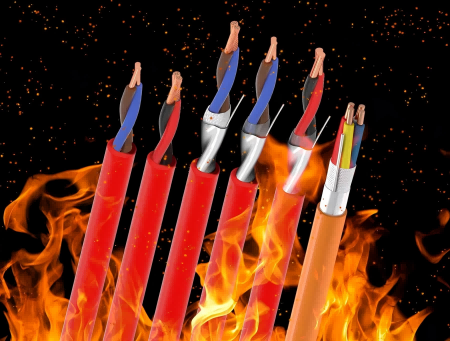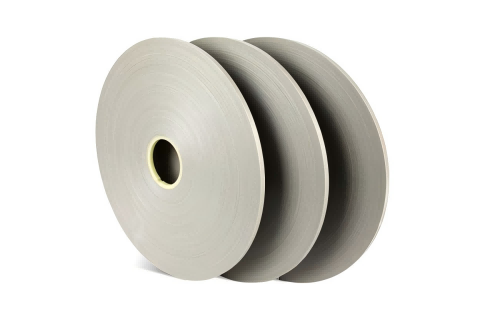The fire resistance of cables is crucial during a fire, and the material selection and structural design of the wrapping layer directly affect the overall performance of the cable. The wrapping layer typically consists of one or two layers of protective tape wrapped around the insulation or inner sheath of the conductor, providing protection, buffering, thermal insulation, and anti-aging functions. The following explores the specific impact of the wrapping layer on fire resistance from various perspectives.
1. Impact of Combustible Materials
If the wrapping layer uses combustible materials (such as Non-woven fabric tape or PVC tape), their performance in high-temperature environments directly affects the cable’s fire resistance. These materials, when burned during a fire, create deformation space for the insulation and fire resistance layers. This release mechanism effectively reduces the compression of the fire resistance layer due to high-temperature stress, lowering the likelihood of damage to the fire resistance layer. In addition, these materials can buffer the heat during the early stages of combustion, delaying the heat transfer to the conductor and temporarily protecting the cable structure.
However, combustible materials themselves have limited ability to enhance the fire resistance of the cable and typically need to be used in conjunction with fire-resistant materials. For example, in some fire-resistant cables, an additional fire barrier layer (such as mica tape) can be added over the combustible material to improve overall fire resistance. This combined design can effectively balance material costs and manufacturing process controllability in practical applications, but the limitations of combustible materials must still be carefully evaluated to ensure the cable’s overall safety.
2. Impact of Fire-Resistant Materials
If the wrapping layer uses fire-resistant materials such as coated glass fiber tape or mica tape, it can significantly improve the cable’s fire barrier performance. These materials form a flame-retardant barrier at high temperatures, preventing the insulation layer from directly contacting flames and delaying the melting process of the insulation.
However, it should be noted that due to the tightening action of the wrapping layer, the expansion stress of the insulation layer during high-temperature melting may not be released outward, resulting in significant compressive impact on the fire resistance layer. This stress concentration effect is especially pronounced in steel tape armored structures, which may reduce fire resistance performance.
To balance the dual requirements of mechanical tightening and flame isolation, multiple fire-resistant materials can be introduced into the wrapping layer design, and the overlap rate and wrapping tension can be adjusted to reduce the impact of stress concentration on the fire resistance layer. In addition, the application of flexible fire-resistant materials has gradually increased in recent years. These materials can significantly reduce the stress concentration issue while ensuring fire isolation performance, contributing positively to improving overall fire resistance.
3. Fire Resistance Performance of Calcined Mica Tape
Calcined mica tape, as a high-performance wrapping material, can significantly enhance the cable’s fire resistance. This material forms a strong protective shell at high temperatures, preventing flames and high-temperature gases from entering the conductor area. This dense protective layer not only isolates flames but also prevents further oxidation and damage to the conductor.
Calcined mica tape has environmental advantages, as it does not contain fluorine or halogens and does not release toxic gases when burned, meeting modern environmental requirements. Its excellent flexibility allows it to adapt to complex wiring scenarios, enhancing the cable’s temperature resistance, making it particularly suitable for high-rise buildings and rail transport, where high fire resistance is required.
4. The Importance of Structural Design
The structural design of the wrapping layer is crucial for the cable’s fire resistance. For example, adopting a multi-layer wrapping structure (such as double or multi-layer calcined mica tape) not only enhances the fire protection effect but also provides a better thermal barrier during a fire. In addition, ensuring that the overlap rate of the wrapping layer is no less than 25% is an important measure to improve overall fire resistance. A low overlap rate may lead to heat leakage, while a high overlap rate may increase the mechanical rigidity of the cable, affecting other performance factors.
In the design process, the compatibility of the wrapping layer with other structures (such as the inner sheath and armor layers) must also be considered. For example, in high-temperature scenarios, the introduction of a flexible material buffer layer can effectively disperse thermal expansion stress and reduce damage to the fire resistance layer. This multi-layer design concept has been widely applied in actual cable manufacturing and shows significant advantages, especially in the high-end market of fire-resistant cables.
5. Conclusion
The material selection and structural design of the cable wrapping layer play a decisive role in the cable’s fire resistance performance. By carefully selecting materials (such as flexible fire-resistant materials or calcined mica tape) and optimizing structural design, it is possible to significantly enhance the cable’s safety performance in the event of a fire and reduce the risk of functional failure due to fire. The continuous optimization of wrapping layer design in the development of modern cable technology provides a solid technical guarantee for achieving higher performance and more environmentally friendly fire-resistant cables.
Post time: Dec-30-2024



